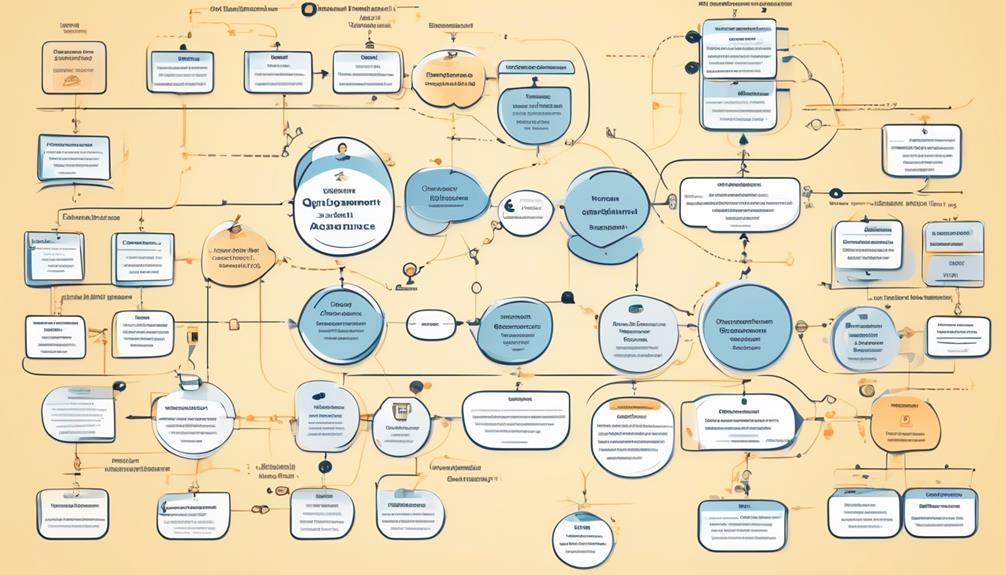Welcome to our guide on boosting your website’s performance optimization! In today’s digital age, the speed and efficiency of your site are crucial for its success. Improving your website’s loading time can significantly improve user experience and boost your conversion rates. Research conducted by Portent reveals that B2B websites with a 1-second load time achieve conversion rates three times higher than those taking 5 seconds to load. This highlights the significance of investing in performance optimization to unleash the full potential of your website.
Key Takeaways:
- Website speed optimization is essential for improving user experience and increasing conversion rates.
- Optimizing website speed can increase average time on page and reduce bounce rate.
- Implement strategies such as auditing your site, optimizing images, and reducing redirects and HTTP requests.
- Consider evaluating your hosting provider and using a content delivery network (CDN) to optimize content delivery.
- Compress files using tools like Gzip and leverage caching to enhance website performance.
What is Website Speed Optimization?
Website speed optimization involves implementing a range of strategies and best practices to ensure that your website loads as quickly as possible. The goal is to improve website performance, leading to a better user experience and increased conversion rates. Research has shown that the longer a website takes to load, the more likely visitors are to abandon it. Therefore, optimizing website speed is crucial for maximizing conversions and overall website performance.
Why is Website Speed Optimization Important?
Optimizing your website speed offers numerous benefits beyond just a faster loading time. Here are a few reasons why it’s vital to prioritize website speed optimization:
- Higher Conversion Rate: Studies have consistently shown that customers are more likely to convert on websites that load quickly. For example, a report by Portent found that a website that loads in 1 second has a conversion rate three times higher than a site that loads in 5 seconds. By optimizing speed, you can improve your conversion rate and ultimately drive more sales.
- Lower Bounce Rate: Slow-loading websites often have high bounce rates, as visitors are more likely to leave if they experience delays. By optimizing your website’s speed, you can decrease bounce rates and keep users engaged for longer periods.
- Improved User Experience: A fast-loading website provides a positive user experience, enhancing customer satisfaction. Users are more likely to stay on your site, engage with your content, and return in the future if they have a seamless browsing experience.
Optimizing Website Speed: Best Practices
To optimize your website speed effectively, consider implementing the following strategies:
- Minimize HTTP Requests: Reduce the number of HTTP requests by minimizing the amount of content on your site that requires loading. Combine CSS and JavaScript files, remove unused code, and leverage browser caching.
- Optimize Images: Compress and resize images to the appropriate dimensions without sacrificing quality. Use formats such as JPEG and PNG, and consider modern formats like WebP for even more significant file size reduction.
- Enable Browser Caching: Leverage browser caching to store static assets on visitors’ devices, reducing the need for subsequent requests when returning to your site.
- Utilize Content Delivery Networks (CDNs): CDNs distribute your website’s content across multiple servers worldwide, reducing latency and improving loading speeds for users in different geographical locations.
- Implement Gzip Compression: Enable Gzip compression on your server to decrease file sizes and reduce the time it takes to transfer them to visitors’ browsers.
To further enhance your website speed optimization efforts, conduct regular performance audits, monitor load times, and analyze user feedback. Continuously optimize and fine-tune your website to ensure it delivers the best possible performance.

“Website speed optimization is not just about making your site load faster; it’s about improving the overall user experience and increasing your conversion rates. By implementing a range of strategies, such as minimizing HTTP requests, optimizing images, enabling browser caching, utilizing CDNs, and leveraging Gzip compression, you can significantly enhance your website’s performance and achieve your business goals.” – Website Speed Experts Team
| Benefits of Website Speed Optimization | Strategies for Website Speed Optimization |
|---|---|
| 1. Higher Conversion Rate 2. Lower Bounce Rate 3. Improved User Experience |
1. Minimize HTTP Requests 2. Optimize Images 3. Enable Browser Caching 4. Utilize CDNs 5. Implement Gzip Compression |
How to Optimize Your Website Speed
To optimize your website speed, we recommend following several strategies and best practices. By implementing these website optimization techniques, you can improve your website’s performance, ensure a smooth user experience, and boost your conversion rates.
Audit Your Website Performance
Start by conducting a thorough website performance analysis using tools like PageSpeed Insights. This will help identify areas where your website can be optimized for speed. Pay close attention to page load times, server response times, and other performance metrics. Prioritize potential fixes based on what matters most to your visitors.
Evaluate Your Hosting Provider
Your choice of hosting provider can have a significant impact on your website’s speed. Evaluate your current hosting plan and consider switching to a better one if necessary. Look for hosting providers that offer fast servers, reliable uptime, and excellent customer support. A hosting plan optimized for website speed can greatly improve your overall performance.
Utilize a Content Delivery Network (CDN)
A content delivery network (CDN) is a network of servers distributed across various locations. By utilizing a CDN, you can optimize content delivery and reduce latency. When a user visits your website, the CDN delivers content from the server closest to their location, ensuring faster load times. This website speed optimization technique is especially beneficial for websites with a global audience.
Optimize Your Images
Images are essential elements of a website, but they can also slow down your website if not optimized properly. Compress your images to reduce their file size without compromising quality. Consider using tools like TinyPNG to compress common image file formats. Additionally, consider using the WebP format, which provides superior compression compared to traditional formats. Optimizing your images is a crucial step in website speed optimization.
Reduce Total Redirects
Website redirects can negatively impact page load times. Minimize the number of redirects on your website by replacing old redirects with updated content as soon as possible. This will help reduce server load and improve website speed.
Limit HTTP Requests
Every HTTP request made by your website adds to the load time. Limit the number of HTTP requests by optimizing your website’s code, combining and minifying CSS and JavaScript files, and reducing the number of external resources. This will help improve website speed and performance.
Compress Files Using Gzip
File compression is an effective technique for reducing file sizes and improving website speed. Enable Gzip compression on your server to compress files before sending them to visitors’ browsers. This compression technique can greatly reduce file sizes and enhance website performance.
Leverage Caching
Implement caching strategies to store frequently accessed website content. Browser caching and server-side caching can help deliver website pages more quickly to returning visitors, reducing load times significantly. Utilize caching plugins or leverage built-in caching features in your content management system (CMS) to optimize your website’s performance.
Track and Fix 404 Errors
Broken links and 404 errors can negatively impact user experience and website performance. Regularly monitor your website for 404 errors and fix them promptly. Use a tool to track broken links and update them with relevant content or redirects. Keeping your website error-free will improve user experience and contribute to faster loading times.
Mobile Optimization
Make mobile optimization a priority. With the increasing use of mobile devices for website browsing, it’s crucial to ensure your website is mobile-friendly. Optimize your website’s design and content for smaller screens, use responsive design, and prioritize mobile user experience. This will not only improve website performance on mobile devices but also positively impact your search engine rankings.
By implementing these website optimization techniques, you can optimize your website speed, improve website performance, and provide a seamless user experience. Remember, a fast-loading website is crucial for engaging visitors, reducing bounce rates, and ultimately boosting your conversion rates.

Evaluate Your Current Hosting Provider
When it comes to website speed, your hosting provider plays a crucial role. The right hosting plan can significantly improve your website’s performance and overall speed. On the other hand, a poor hosting provider can lead to slow loading times and frustrated visitors.
If you’re currently using shared hosting, which is a cost-effective option, it may result in lower overall performance. Shared hosting means your website shares server resources with other websites, which can cause slower loading times during peak traffic periods.
If you need more control and better performance, you might consider virtual private servers (VPS). VPS hosting offers improved speed and performance compared to shared hosting. However, high resource loads can still affect the speed of your website.
If speed is your top priority and you have a higher budget, dedicated servers are the way to go. With dedicated servers, you have an entire server dedicated solely to your website. This provides the best speed regardless of resource load and ensures optimal performance.
To evaluate your current hosting provider, consider the following factors:
- Speed and performance: Test your website’s loading times and overall performance. Slow loading times can indicate that your hosting provider is not meeting your needs.
- Availability and uptime: Check if your website experiences frequent downtime or if it’s consistently available to visitors. Constant downtime can harm your website’s performance and user experience.
- Customer support: Assess the quality of customer support provided by your hosting provider. Inefficient or unresponsive support can hinder the resolution of any speed or performance issues.
- Scalability: Determine if your hosting plan allows for easy scalability as your website grows and attracts more traffic. A flexible hosting solution will ensure that your website remains fast and accessible even during peak periods.
If you find that your current hosting provider is not meeting your needs, it may be time to switch to a better plan or provider. Don’t hesitate to invest in a hosting solution that prioritizes website speed and performance – it will pay off in the long run.

By carefully evaluating your current hosting provider and making the necessary changes, you can optimize your website’s speed and overall performance.
Consider a Content Delivery Network (CDN)
When it comes to optimizing website performance and improving content delivery, a content delivery network (CDN) is a powerful tool. CDNs utilize multiple servers dispersed across different geographical locations to store copies of your website’s content. This strategic distribution ensures that when a user visits your site, the CDN automatically selects the server closest to their location, enabling faster content delivery.
With CDNs, your website’s performance is significantly enhanced, providing a smooth and seamless user experience. By reducing latency and minimizing the distance between the user and the server, CDNs contribute to faster page load times and improved website performance.
In fact, CDNs have become increasingly popular due to their effectiveness in optimizing content delivery. According to data from the Cisco Visual Networking Index, CDNs are expected to handle a staggering 72% of all internet traffic by 2022.
To give you a clearer picture of the benefits of content delivery networks, let’s take a closer look at how CDNs work.
How CDNs Improve Website Performance
CDNs work by strategically caching your website’s content on their distributed servers. This caching process ensures that when a user requests a specific piece of content, it is delivered from a server that is geographically close to them.
This proximity eliminates the need for data to travel long distances between the user and the server, reducing latency and improving website performance. Whether your website contains images, videos, or static files, CDNs ensure that they are served quickly and efficiently.
Furthermore, CDNs also help mitigate the impact of internet congestion and heavy traffic periods. By dispersing content across multiple servers, CDNs can handle larger volumes of requests, ensuring consistent and reliable performance even during peak traffic periods.
Choosing the Right CDN Provider
With the rise in popularity of CDNs, numerous providers offer their services to help optimize website performance. When selecting a CDN provider, it’s essential to consider factors such as network coverage, scalability, reliability, and ease of integration.
A reputable CDN provider should have an extensive network of servers located in diverse geographical regions, ensuring coverage and reliable content delivery worldwide. Additionally, scalability is crucial to accommodate your website’s growth and increasing traffic demands.
Integration should be seamless, allowing you to easily integrate the CDN into your existing infrastructure without significant technical hurdles. By carefully evaluating these factors, you can choose a CDN provider that best meets your specific needs, enhancing your website’s performance and improving user experience.
| Benefits of a Content Delivery Network (CDN) | Explanation |
|---|---|
| Improved Website Performance | CDNs reduce latency, optimize content delivery, and ensure faster page load times, resulting in an enhanced user experience. |
| Global Content Delivery | CDNs have servers located worldwide, allowing your website’s content to be delivered from the server closest to the user’s location, minimizing the distance data needs to travel. |
| Reliable Performance | CDNs can handle heavy traffic periods, ensuring consistent performance even during peak usage, and mitigating the impact of internet congestion. |
Optimize Your Images
Images are a crucial component of any website, capturing the attention and engaging users. However, if not optimized properly, they can significantly slow down website loading times. Fortunately, there are effective strategies to optimize your images and improve website speed.
To start, compressing your images before adding them to your site can greatly reduce their size and enhance loading speed. One handy tool for image compression is TinyPNG, which supports popular file types such as JPG, PNG, and TIFF. By reducing the file size without compromising quality, TinyPNG ensures that your images load quickly while retaining their visual impact.
Another option for image optimization is using the WebP format. Developed by Google, WebP offers superior compression compared to traditional formats like PNG. In fact, according to Google, WebP lossless images are 26% smaller than PNGs. By converting your images to WebP, you can significantly improve website performance without sacrificing image quality.
Implementing image optimization techniques such as compression and utilizing modern formats like WebP can have a significant impact on your website’s loading speed. By reducing image file sizes, you create a smoother user experience, decrease bounce rates, and boost overall website performance.
| Image Format | Average Compression |
|---|---|
| JPG | 30-70% |
| PNG | 50-80% |
| TIFF | 60-80% |
| WebP | 20-80% |
As demonstrated in the table, image compression can achieve significant reductions in file size, resulting in faster loading times and improved website speed.

Benefits of Reducing Total Redirects
Improved User Experience: By reducing redirects, you provide users with a seamless browsing experience. Visitors can quickly access the content they’re looking for without the delay caused by unnecessary page redirection.
Faster Page Load Times: With fewer redirects, the loading process becomes more straightforward and efficient. This leads to faster page load times, which can have a significant impact on user satisfaction and engagement.
Reduced Server Load: Many redirects can place a heavy burden on your server and increase resource usage. By minimizing redirects, you can lighten the load on your server, leading to improved performance and stability.
“Reducing the number of redirects on your website is a crucial step in improving website speed and optimizing user experience. By streamlining the loading process and minimizing unnecessary redirects, you can create a more efficient and user-friendly website.” – Casey, Editor in Chief, Website Optimization Expert
Limit HTTP Requests
Every website’s goal is to load quickly and provide a seamless user experience. However, as your website grows and more content is added, the number of HTTP requests made by the website increases, contributing to longer load times. This, in turn, can lead to lower user engagement and potential customer loss. To ensure optimal website speed and performance, it is important to limit HTTP requests.
Reducing the number of HTTP requests can significantly improve website speed and enhance overall performance. Here are some effective strategies to minimize HTTP requests:
- Utilize a Content Delivery Network (CDN): Implementing a CDN allows you to distribute your website’s static content across various servers located in different geographic locations. This strategy minimizes the distance between users and your content, reducing latency and improving website speed.
- Minify CSS and JavaScript files: Optimizing your website’s code by removing unnecessary characters, spaces, and comments can reduce file sizes, resulting in fewer HTTP requests and faster load times.
- Optimize content delivery: Efficiently delivering content to website visitors is crucial for speed optimization. Compressing images, implementing lazy loading on images and videos, and using responsive design techniques can help reduce the number of HTTP requests made by your website.
Did You Know? According to a study by Google, reducing the number of HTTP requests by 50% can result in a 50% decrease in page load time.
By employing these strategies and optimizing your website’s HTTP requests, you can significantly improve website speed, enhance user experience, and increase customer engagement.
| HTTP Request Optimization Techniques | Benefits |
|---|---|
| Utilizing a Content Delivery Network (CDN) | – Reduced latency – Faster content delivery – Improved website speed |
| Minifying CSS and JavaScript files | – Reduced file sizes – Fewer HTTP requests – Faster load times |
| Optimizing content delivery | – Compressed images – Lazy loading of assets – Responsive design – Reduced number of HTTP requests |
Tip: Utilize tools like Google PageSpeed Insights or GTmetrix to analyze your website’s HTTP requests and identify potential areas for improvement.
Compress, Compress, Compress
File compression is a crucial technique for reducing the size of files without compromising their quality. It plays a vital role in optimizing website performance and improving overall user experience. One widely used method of compression is Gzip compression, which can significantly reduce file size without negatively impacting website speed.
Studies show that over 88% of websites utilize file compression to enhance their website performance. Among these websites, nearly 60% specifically leverage Gzip compression to achieve optimal results. By enabling Gzip compression, you can effectively reduce file sizes and improve the loading speed of your website, ensuring a seamless and efficient user experience.
To fully optimize your website’s performance, it is important to ensure that your web hosting service supports file compression. Check with your hosting provider to verify if they have Gzip compression enabled or if there are any steps you need to take to enable it. By implementing Gzip compression, you can significantly enhance your website’s performance, resulting in faster loading times and improved user satisfaction.
The Benefits of Gzip Compression
Gzip compression offers several key benefits for website performance optimization:
- Reduced File Sizes: Gzip compression significantly reduces the size of HTML, CSS, and JavaScript files, minimizing the data that needs to be transferred between the server and the user’s browser.
- Improved Loading Speed: By reducing file sizes, Gzip compression allows websites to load faster, providing a seamless browsing experience for users.
- Bandwidth Savings: Compressed files require less bandwidth, resulting in cost savings for both website owners and users.
- Positive SEO Impact: Faster-loading websites tend to rank higher in search engine results, improving visibility and attracting more organic traffic.
“Gzip compression is a simple yet effective method for improving website performance. By reducing file sizes, it allows websites to load faster, resulting in enhanced user experience and increased chances of conversion.”
Gzip Compression vs. Other Compression Methods
While Gzip compression is widely adopted, several other compression methods are available. Here’s a brief comparison of Gzip compression with other common compression techniques:
| Compression Method | Advantages | Disadvantages |
|---|---|---|
| Gzip Compression | – Highly effective at reducing file sizes – Widely supported by web servers and browsers |
– Requires server-side configuration – Works best with text-based files |
| Brotli Compression | – Provides higher compression ratios than Gzip – Optimized for modern web standards |
– Requires server-side configuration – Might not be supported by older web browsers |
| Deflate Compression | – Supported by most web servers and browsers – Easy to implement |
– Less efficient compression compared to Gzip and Brotli – Can lead to larger file sizes than other methods |
While each compression method has its advantages and disadvantages, Gzip compression remains a popular choice due to its widespread support and effectiveness at reducing file sizes.
Capitalize on Caching
Website caching and browser caching are essential components of website optimization. By implementing caching strategies, you can significantly improve your website’s speed and overall performance. Caching allows browsers to pre-load content, reducing the time it takes to deliver web pages to users.
Many content management systems (CMS) come with built-in caching features that you can leverage to optimize your website. However, if your CMS doesn’t offer this functionality, don’t worry! You can install a caching plugin to achieve the same results. One popular plugin is the SiteGround Optimizer, which offers a range of optimization features, including file compression, caching, and code optimization.
With caching enabled, your website’s pages will load faster, enhancing user experience and improving conversion rates. It’s a simple yet effective way to optimize your website for better performance.
Advantages of Website Caching
Here are some key advantages of implementing website caching:
- Improved website speed: Caching reduces the time it takes for web pages to load, resulting in faster and more responsive websites.
- Enhanced user experience: Faster page load times lead to a smoother and more enjoyable browsing experience for your visitors.
- Reduced server load: Caching helps distribute the load on your server, preventing performance bottlenecks during peak traffic periods.
- Lower bandwidth usage: By pre-loading and storing content locally, caching reduces the amount of data that needs to be transmitted over the network, resulting in lower bandwidth consumption.
How to Enable Website Caching
Enabling website caching depends on the CMS you’re using or the caching plugin you install. Here’s a general guide to enable caching:
- Access your CMS or caching plugin settings.
- Locate the caching options.
- Enable caching by toggling the feature or specifying the caching rules.
- Save your changes.
Once caching is enabled, make sure to monitor your website’s performance to ensure that caching is working properly and that your website remains optimized.
| Benefits of Caching | Example CMS/Plugin | Price |
|---|---|---|
| Optimized website performance | SiteGround Optimizer | Free |
| Improved user experience | WP Rocket | $49/year |
| Reduced server load | WP Super Cache | Free |
Track 404 Errors
Website error tracking is essential for maintaining a seamless user experience and ensuring that broken links do not hinder your website’s performance. One common error that users encounter is the 404 error, which occurs when they try to access a page that no longer exists or has been moved. These errors can be frustrating for visitors and can potentially lead to lost customers.
To prevent 404 errors from negatively impacting your website, it is crucial to regularly monitor and track them using external tools. These tools help you identify broken links and take the necessary steps to fix them promptly.
Benefits of Tracking 404 Errors
By actively tracking 404 errors on your website, you can benefit in several ways:
- Enhanced User Experience: Resolving broken links ensures that users can navigate your website without encountering frustrating dead ends. This improves overall user experience and encourages visitors to explore further.
- Reduced Bounce Rates: When users come across broken links, they are more likely to leave your website immediately. By addressing 404 errors, you can reduce bounce rates and keep visitors engaged.
- Retained Potential Customers: Every visitor to your website has the potential to become a customer. By fixing broken links and providing a seamless browsing experience, you can retain and convert more potential customers.
Regularly tracking and addressing 404 errors demonstrates your commitment to providing a smooth and user-friendly website experience. It also helps search engines recognize your website’s relevance and credibility, positively impacting your search engine rankings.
External Tools for Tracking 404 Errors
Several external tools can assist you in tracking and fixing 404 errors on your website:
- Google Search Console: This free tool from Google allows you to monitor and resolve issues related to broken links, including 404 errors. It provides insights into the URLs generating errors, allowing you to take corrective actions swiftly.
- Broken Link Checker: This online tool scans your website for broken links and provides detailed reports highlighting the URLs that need attention. It enables you to fix broken links efficiently and maintain a seamless browsing experience for your users.
- Website Auditor: This comprehensive SEO tool includes a feature for tracking and managing 404 errors. It helps you identify broken links, provides recommendations for fixing them, and monitors their status to ensure they are resolved effectively.
By utilizing these tools and actively tracking and addressing 404 errors, you can ensure that your website maintains optimal performance and delivers an exceptional user experience.
| Tool | Key Features |
|---|---|
| Google Search Console | Monitors and resolves broken links Provides insights into URLs causing 404 errors |
| Broken Link Checker | Scans website for broken links Generates detailed reports for efficient fixing |
| Website Auditor | Identifies and recommends fixes for broken links Monitors and verifies resolution status |
Conclusion
Improving the performance of your website is crucial in ensuring a seamless user experience and maximizing your conversion rates. By implementing the strategies mentioned throughout this article, such as optimizing your website speed, conducting regular site audits, optimizing images, reducing redirects and HTTP requests, and utilizing caching and compression techniques, you can significantly enhance the performance and loading speed of your website. It is essential to continuously monitor and optimize your website’s performance to maintain a fast and user-friendly site.
Website performance optimization plays a vital role in attracting and retaining visitors, as well as improving search engine rankings. Whether your website is an e-commerce platform, a blog, or a corporate site, optimizing its speed and performance is crucial in today’s digital landscape. By addressing potential bottlenecks, optimizing content delivery, and implementing compression and caching strategies, you can ensure that your website loads quickly and efficiently for every visitor.
Remember, a fast-loading website not only enhances user experience but also positively impacts your bottom line. Studies have consistently shown that even a one-second delay in page load time results in decreased user satisfaction and increased bounce rates. On the other hand, a fast and efficient website generates higher engagement, longer time spent on page, and ultimately, more conversions. Prioritize website performance optimization to give your visitors the best possible experience and gain a competitive edge in the online marketplace.
FAQ
What is website performance optimization?
Website performance optimization refers to a set of strategies and best practices aimed at making a website as fast as possible. It aims to improve website performance, user experience, and conversion rates.
Why is website speed optimization important?
Website speed optimization is crucial for improving user experience and achieving higher conversion rates. Studies show that the longer a site takes to load, the lower the conversion rate. Optimizing website speed can increase average time on page, reduce bounce rate, and convert more visitors into customers.
How can I optimize my website speed?
To optimize your website speed, you can follow several strategies and best practices. Start by auditing your site’s performance, prioritize potential fixes, evaluate your hosting provider, utilize a content delivery network (CDN), optimize your images, reduce redirects and HTTP requests, compress files, leverage caching, and track and fix 404 errors.
How can I evaluate my current hosting provider?
Your choice of hosting provider can impact your website speed. Evaluate your current hosting provider and consider switching to a better plan if necessary. Shared hosting options are cost-effective but may result in lower overall performance. Virtual private servers (VPS) offer improved performance but can still face speed issues with high resource loads. Dedicated servers provide the best speed regardless of resource load but are more expensive.
What is a content delivery network (CDN) and why should I consider using one?
A content delivery network (CDN) is a solution for optimizing content delivery and improving website performance. CDNs use multiple servers located in different geographic locations to store replications of your content. They choose the server closest to a user’s location to optimize content delivery. CDNs have become increasingly popular and are expected to carry 72% of internet traffic by 2022.
How can I optimize my images to improve website speed?
Optimize your images by compressing them before adding them to your site. Use tools like TinyPNG to compress common file types such as JPG, PNG, and TIFF. Consider using the WebP format, which provides superior compression for images.
Why should I reduce the total number of redirects on my website?
Redirects can slow down page load times and increase server load. While redirects are useful for connecting high-ranking pages to newer content, it’s important to minimize the number of redirects on your site. Replace old redirects with new content as soon as possible to minimize load times and improve overall website speed.
How can I limit the number of HTTP requests on my website?
Every HTTP request made by a website adds to the overall load time. To limit the number of HTTP requests, consider using a CDN, minifying CSS and JavaScript files, and optimizing your site’s content delivery. These strategies can help reduce the load on the server and improve website speed.
Why is file compression important for website performance?
File compression plays a crucial role in reducing file sizes without compromising quality. Gzip compression is widely used and can reduce the size of files without impacting user experience. Ensure that your web hosting service supports compression and consider enabling Gzip compression to optimize your website’s performance.
How can caching improve my website’s performance?
Caching allows browsers to pre-load content and deliver web pages more quickly. Many content management systems (CMS) have built-in caching features, but if your CMS doesn’t offer this, consider installing a caching plugin. Take advantage of caching to speed up content delivery and enhance overall website performance.
Why is it important to track and fix 404 errors on my website?
404 errors occur when users try to access a page that no longer exists or has been moved. These errors can negatively impact user experience and result in lost potential customers. Regularly monitor and track 404 errors using external tools to identify and fix broken links. By addressing 404 errors, you can enhance user experience, reduce bounce rates, and retain potential customers.
How can I improve website performance optimization?
Improving website performance optimization is essential for enhancing user experience and achieving higher conversion rates. By following the strategies mentioned in this article, including optimizing website speed, evaluating your hosting provider, utilizing a CDN, optimizing images, reducing redirects and HTTP requests, compressing files, leveraging caching, and tracking and fixing 404 errors, you can significantly improve your website’s performance and loading speed.
At the helm of our content team is Amelia, our esteemed Editor-in-Chief. Her extensive background in technical writing is matched by her deep-seated passion for technology. Amelia has a remarkable ability to distill complex technical concepts into content that is not only clear and engaging but also easily accessible to a wide range of audiences. Her commitment to maintaining high-quality standards and her keen understanding of what our audience seeks are what make her an invaluable leader at EarnQA. Under Amelia’s stewardship, our content does more than just educate; it inspires and sets new benchmarks in the realm of QA education.










